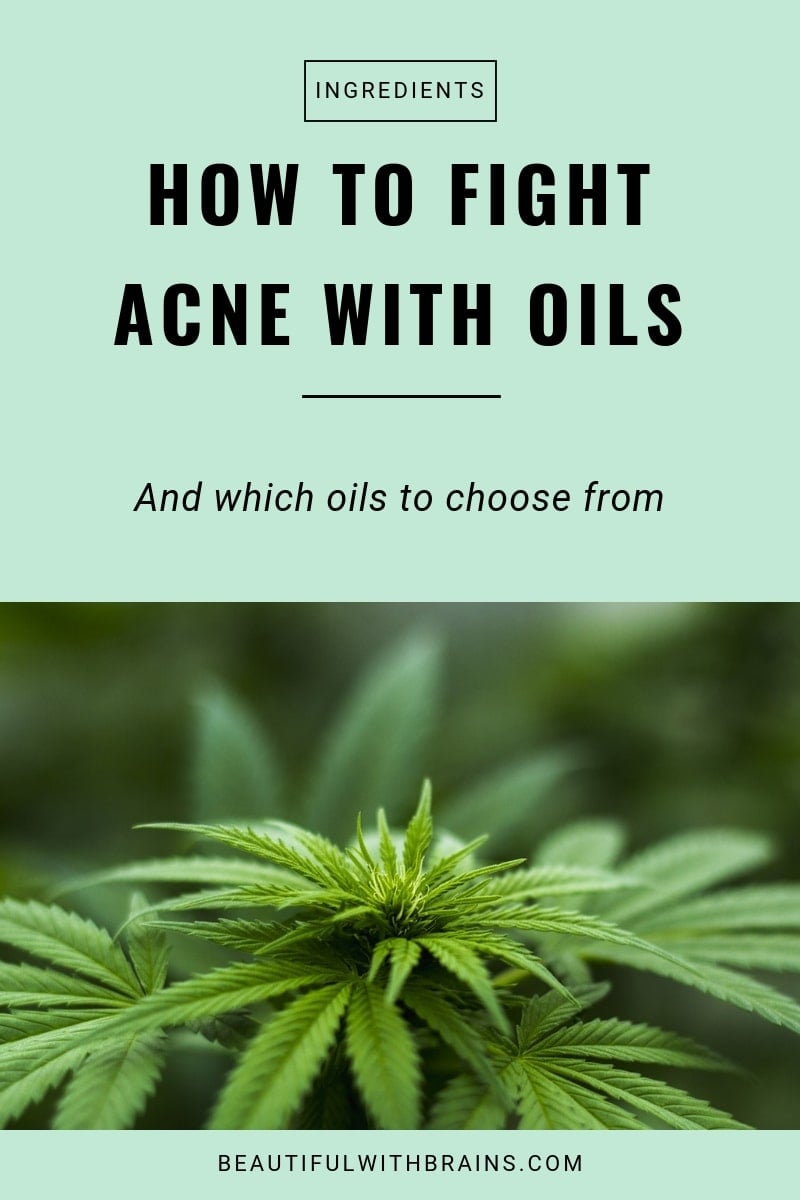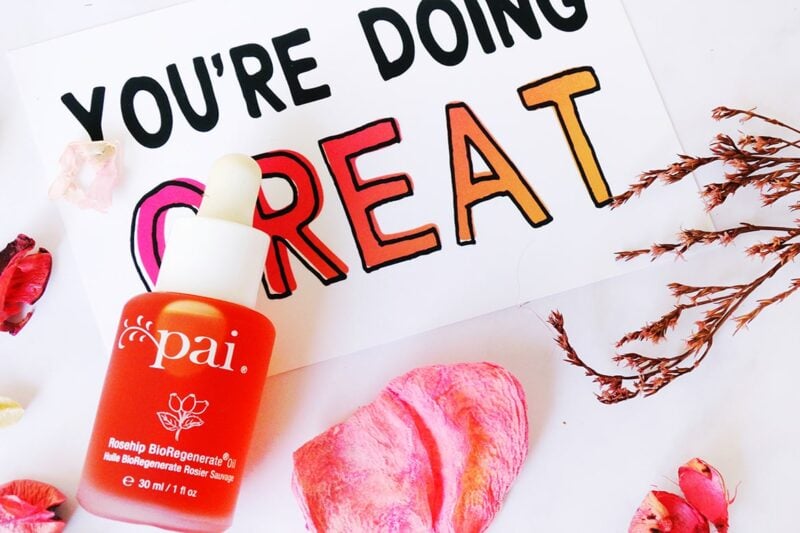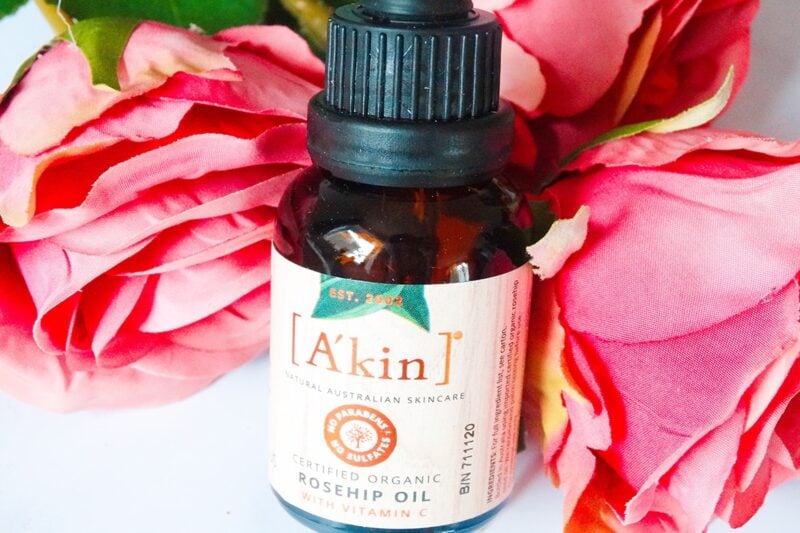
Say what???!!! Oils for acne-prone skin?!
“Have you gone mad, Gio? Oil is the reason my skin is in such a mess in the first place! And you want me to add more?!”
Yes. Hear me out. I’m not saying you should use just any oil. Some do make your acne flare up like crazy.
But others… others help you regulate oil production, clear up your skin and keep your acne at bay. Really.
Here’s how they work their magic:
Linoleic Acid, A Kick-Ass Acne Fighter
Let me introduce you to your new BFF, linoleic acid. It’s an omega-6 essential fatty acid…
Ok, let me start again. Linoleic acid is a fat. An essential fat (or essential fatty acid, to be precise). Essential means your body can’t produce it.
And here lies the problem. Linoleic acid is naturally present in your skin. But when you have acne, your skin has way less linoleic acid than it needs.
Cue acne. Dryness. Sensitivity. All sorts of bad things, basically.
Related: Adult Acne: Why It Happens And How To Treat It
What Does Linoleic Acid Help Skin?
Linoleic acid is one of those things you take for granted until it’s gone. Here’s all it does for you:
- It’s moisturizing: It makes even the driest of skin soft and smooth
- It’s anti-inflammatory: It soothes redness and irritations
- It’s healing: It helps skin heal faster
- It “exfoliates”: It’s involved in the natural exfoliating process
- It lightens: It treats hyperpigmentation
It’s quite the multitasker, isn’t it?
Without it, skin goes bad…
Without enough moisture, your skin gets all dry and flaky. It’s more prone to irritations. It heals way more slowly. And it’s pimples galore.
You see how important it is to make sure your skin always has enough linoleic acid?
Related: The Battle Of The Skin-Lighteners: Which One Is The Best Alternative To Hydroquinone?
Struggling to put together a skincare routine that tackles both acne and wrinkles at the same time? Download your FREE “Best Skincare Routine For Acne + Aging Skin” cheatsheet to get started (it features product recommendations + right application order):
How Linoleic Acid Helps Treat Acne
“Ok, but this post is about acne. Can we go back to it, Gio?”
Sure. Linoleic acid fights acne in three ways:
1. It Promotes Exfoliation
Here’s the deal: it’s true your skin produces too much oil already. BUT it also lacks a specific kind of oil. You guessed it… Linoleic acid.
Scientists think that linoleic acid plays a key role in the natural exfoliation process. Yep, your skin can exfoliate on its own. When it does, dead skin cells get off your skin. When it doesn’t, they get trapped in the pores, clog them up and become food for acne bacteria (the little buggers thrive on this stuff!).
That’s why I keep telling everyone with acne to jump on the salicylic acid bandwagon, pronto! It helps your skin do the exfoliating job and keep those pores clean.
Adding linoleic acid back into your skin helps with exfoliation and acne too. Studies show that using linoleic acid every day for a month reduces spot size and incidence by 25%.
Related: Why Salicylic Acid Is The Key To Spot-Free Skin
2. It Regulates Oil Production
Did you know the right kind of oil can make your skin stop producing so much of the wrong kind? Here’s what I mean…
Sebum production is a hormonal matter. An enzyme 5α-reductase turns testotesrone into the (evil) superhero α-dihydrotestosterone.
In plain English, this combo is bad news for your skin. It pumps up your oil production up a notch… or ten. Cue acne.
Linoleic acid can inhibit the activity of 5α-reductase, keeping oil production under control.
Related: What The Heck Is Sebum?
3. It’s Anti-Inflammatory
I’ll be brief. Acne is an inflammatory disease. When it shows up, it means your immune system is busy fighting off a threat.
Lots of things can cause inflammation. A diet rich in sugar and poor in vegs. Unprotected sun exposure. Pollution. Smoking. To name just a few culprits.
Linoleic acid can soothe inflammation. Turn that down and your acne will start to disappear.

Does Linoleic Acid Have Any Side Effects?
Not so much for your skin. More for your wallet. Let me explain…
Linoleic acid is an unsaturated fatty acid. Unsaturated fatty acids go bad pretty fast. So any oil with a high amount of linoleic acid will go bad faster than oils with a small amount of them.
You’ll know when your oil goes bad. It’ll become rancid and start to smell awful. Sometimes, the colour can change, too.
There are ways to make your unsaturated oils last longer:
- Packaging matters: Only buy oils and creams packaged in an opaque bottle.
- Store them properly: In a cool, dark place away from light and heat.
- Preserve them right: Adding antioxidants like vitamin E slows down deterioration.
- Use them quickly: Don’t forget them in a drawer for months!
Related: How To Tell When A Skincare Product Has Gone Bad
What Are The Best Oils With Lanoleic Acid?
There are a few but I’ll mention the ones more common in skincare:
- Evening Primrose oil (75%)
- Grapeseed oil (72%)
- Hemp seed oil (55%)
- Rosehip oil (45%)
- Safflower oil (68%)
NOTE: these are rough estimates. The exact amount of linoleic acid in each batch of oil varies depending on how the plant was grown (soil, climate etc).
You can find them here:
- Kiki Health CBD Oil 5% (£40.00): available at Cult Beauty
- Now Foods Grapeseed Oil Sensitive Skin Care ($5.79): available at Walmart
- Trilogy Certified Organic Rosehip Oil (£19.50): available at Feel Unique
PRO TIP: when looking for creams/lotions with oils high in linoleic acid, make sure they’re at the top of the ingredient list. If you’re looking for a standalone oil, get the purest grade you can find. Make sure it has vitamin E to help it last longer, too!

How To Use Linoleic Acid To Treat Acne
You have three options here:
- Cleanser: You can use it to cleanse your face at night to dissolve the oils on your skin and makeup (Oil Cleansing Method)
- Moisturizer: You can use it as a facial oil after or in place off of your moisturizer
- Booster: You can mix a few drops with your fave moisturizer/serum
Related: What Is The Oil Cleansing Method And Why You Should Do It?
Can You Use Linoleic Acid As Your Only Anti-Acne Weapon?
You could… but I don’t recommend it.
Pimples happen when the clogs in your pores get infected with bacteria (P. Acnes, to be precise).
Linoleic acid can’t kill P.Acnes. Traditional anti-acne remedies like benzoyl peroxide or tea tree oil can.
That’s why it’s best to use linoleic acid as part of your anti-acne toolkit. It tackles other causes of acne, the factors that make P.Acnes thrive so much. Starve the damn thing and it’ll slowly go away.
Related: Tea Tree Oil, The Underdog Acne Fighter
The Bottom Line
Linoleic acid tackles acne in a different way: it promotes exfoliation, regulates oil production and reduces inflammation. That makes any oil high in it a powerful ally in your fight against acne. Go on, give it a go. You’ll be amazed.

Is it smart to combine linoleic acid oils with other oils as part of the oil-cleansing method? For instance, say I combined it with castor oil and olive oil. Would that be a good idea? Or is it more effective to use it alone?
Claire, I’d use them alone. Depending on the concentration of other oils, they may cause problems for your skin.
Hello Gio. Some time ago I’ve discovered your blog and I can say that back then I’ve read all of it (literally – page by page). It’s interesting , well documented and I’ve loved your no bulls**t reviews about what’s working or not in skin care – ingredient wise. Anyway, if it’s OK for you I’d love to know your opinion about the ageing effects of oil presented in this article: https://theskincareedit.com/2017/02/22/squalane
and this: https://theskincareedit.com/2014/02/17/cause-of-skin-aging. I don’t know what to think anymore about vegetable face oils.
Hope to hear from you but if not, it’s OK, I”m still reading your one of a kind beauty blog. Greetings from Romania!
Gabi, first of all, let me tell you that all your comments went through. It’s just that when a person comments for the first time or adds more than a link to the comment, the comment ends up in my moderation queue. This is to avoid spam. I try to approve all good comments once a week but the past few weeks have been so hectic that I’ve fallen way behind with comments. That’s why they didn’t appear. I’m sorry for the inconvenience.
Thanks for bringing this to my attention. I’m not sure what she bases her recommendation on as she doesn’t cite any scientific studies. My guess is that she’s basing her arguments on nutritional studies. When PUFA oils are consumed in large quantities, they can indeed cause inflammation, which triggers free radicals and leads to premature aging. There’s no proof this happens when you put these oils on your skin. On the contrary, there are plenty of studies that show that oils like rosehip prevents and treat premature aging.
One more thing: completely removing PUFA oils from your diet is NOT a good idea as your body needs them too. In moderation. When you consume more omega-3 fatty acids than PUFA, your skin and body are happy. But in our Western diets, PUFA are everywhere so we eat way more of them than omega-3. It’s this unbalance between omega-3 and PUFA, not the PUFA oil itself, that leads to premature aging.
Gio, can you just open up a capsule of evening primrose oil, for example, and spread it over your face or do you need to purchase a skin care product specifically designed for this purpose? Never heard about linoleic acid for acneic skin. Thank you for sharing this!
GEO, I prefer to use specific skincare products because they’re properly formulated and offer more benefits. But you could use a capsule, if it states it can be used on skin. It really depends on how the oil was refined.
As a teen and continuing until now, my skin always seems flaky on the top layer yet full of clogged pores. At 50, I still fight clogged pores, especially in my t zone, I’m just dryer on the sides now. I am interested in seeing if the linoleic fatty acid would help me. Can you recommend a cleanser ? I have just switched to a gentler cleanser in case I was being too harsh and am only exfoliating about twice a month. Every morning I cleanse, use Zo acid pads for acne control (mostly in my tzone), and follow up with C serum, B 5 serum and sunscreen under my foundation. At night I lightly use salicylic acid in the areas that look clogged (always my nose and chin), the B5 again and four nights a week I use a retrinol product on the sides and forehead for anti-aging. I feel like I have worked and worked for years and just cant seem to get this right.
Deb, I’m confused… you say you’re exfoliating twice a month, but then you use ZO acid pads and salicylic acid every day?! You’re probably exfoliating too much! Zo products are very harsh. I’d try using just a basic salicylic acid exfoliant like Paula’s Choice 2% BHA Liquid every night and see what happens.
I consider “exfoliation” to be using a scrub and never thought of the acids that way. I do use the Zo pads every morning after cleansing. Thank you for the suggestion. I will try it without the Zo pads and see what happens.
I believe flaxseed oil is forgotten here. It is rich in omega-3 fatty acids (linoleic acid and linolenic acid) as well. It also more or less contains omega-9 (oleic acid), palmitic acid and stearic acid as well.